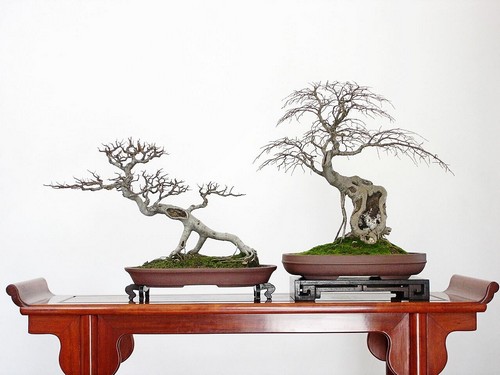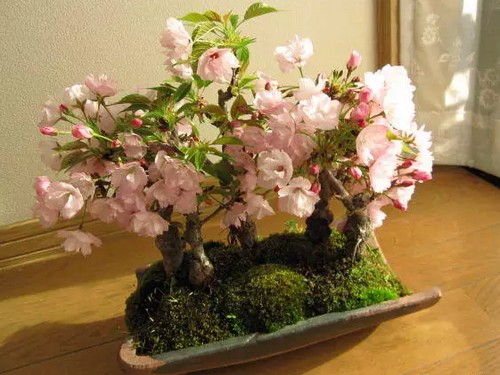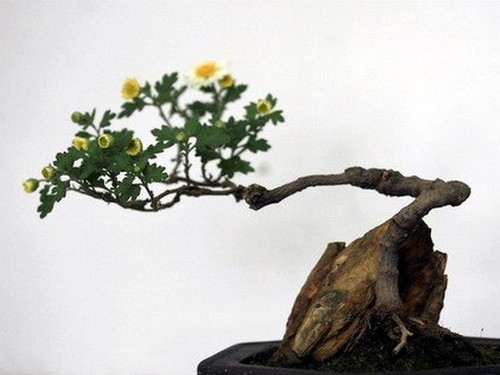The method of making Pushu bonsai
Pushu is a subtropical tree species produced in the Huaihe River Basin, south of Qinling Mountains, as far as Guangdong, Guangxi and other provinces and regions. Most of them are scattered in plain and low mountain areas. Like light, suitable for warm and humid climate, suitable for growing in fertile and flat land. The soil is not strict, has a certain ability to withstand dryness, but also resistant to water and moisture and barren soil, strong adaptability.

Mountain mining:
Pushu is commonly distributed wild in the hills and low mountains and valleys of the Yangtze River basin and its south. It can dig the sprouting old piles of Gucci, which has been cut down for many years, and "raise embryos". After pruning, the root system is developed, new branches are sprouted, and then cultivated. After 1-2 years, the potted trees can be made into vigorous and simple bonsai in a short period of time.
The process of putting on the basin:
1. Selection basin: Park tree bonsai is famous for its antiquity, it is appropriate to use purple sand pottery basin or glazed pottery basin, the shape of the basin is rectangular, square or oval, depending on the tree shape. Because the leaves are dense, the leaves are dark green, and the bark is grayish brown and rough, so the basin color is light yellow or ochre brown, which plays a contrasting role.
2. Using soil: Pushu does not choose soil quality and has strong adaptability, but grows better on sandy loam with fertile, loose and good drainage. Bonsai cultivation is generally made of pastoral soil mixed with sandy soil or rice chaff ash.
3. Planting: it should be done after autumn or before sprouting in spring. When planting, the root system should be pruned properly, cut off the overlong main root, leave more lateral root and whisker root, obstruct to loosen the soil, and prune the branches and leaves properly at the same time. If you plant in a medium-shallow pot, you should use wire to fix the root at the bottom of the basin to avoid lodging.
Orthostatic techniques:
1. Processing: the modeling of Pushu mostly uses the method of coarse binding and fine cutting, while the big tree processing of Lingnan School adopts the method of pruning completely, imitating the painting techniques of Lingnan, paying attention to cutting skills, storing branches and truncation, and paying attention to the effect of overall composition. The processed pile scene can maintain a beautiful shape no matter when the branches and leaves are luxuriant or when the leaves fall in winter.
2. Tree shape: Park tree bonsai is suitable for making straight dry type, oblique dry type, curved dry type, horizontal dry type or stone-attached type and so on. Branches and leaves can be tied or trimmed into steamed bread-shaped circles, or processed into natural trees.
Time: 2019-05-26 Click:
- Prev

The method of making Cherry Blossom Bonsai
With bright colors and luxuriant branches and leaves, cherry blossoms are an important ornamental tree species in early spring and are often used in gardens. Group planting can also be planted on hillsides, courtyards, roadsides and in front of buildings. When it is in full bloom, the flowers are colorful, the trees are in full bloom, such as clouds and clouds, it is very spectacular. Can be planted in large areas to create a landscape of flowers.
- Next

Making methods of different shapes of Chrysanthemum Bonsai
Chrysanthemum is a perennial herbaceous flower of the genus Compositae. The stem is herbaceous and slightly Lignified at the end of its growth. After flowering every year, the aboveground parts wither, leaving persistent roots to survive the winter, and new branches sprout in the next spring. Stem erect or semi-spreading, surface pubescent, easily branched, up to 80150 cm in natural growth
Related
- Fuxing push coffee new agricultural production and marketing class: lack of small-scale processing plants
- Jujube rice field leisure farm deep ploughing Yilan for five years to create a space for organic food and play
- Nongyu Farm-A trial of organic papaya for brave women with advanced technology
- Four points for attention in the prevention and control of diseases and insect pests of edible fungi
- How to add nutrient solution to Edible Fungi
- Is there any good way to control edible fungus mites?
- Open Inoculation Technology of Edible Fungi
- Is there any clever way to use fertilizer for edible fungus in winter?
- What agents are used to kill the pathogens of edible fungi in the mushroom shed?
- Rapid drying of Edible Fungi

